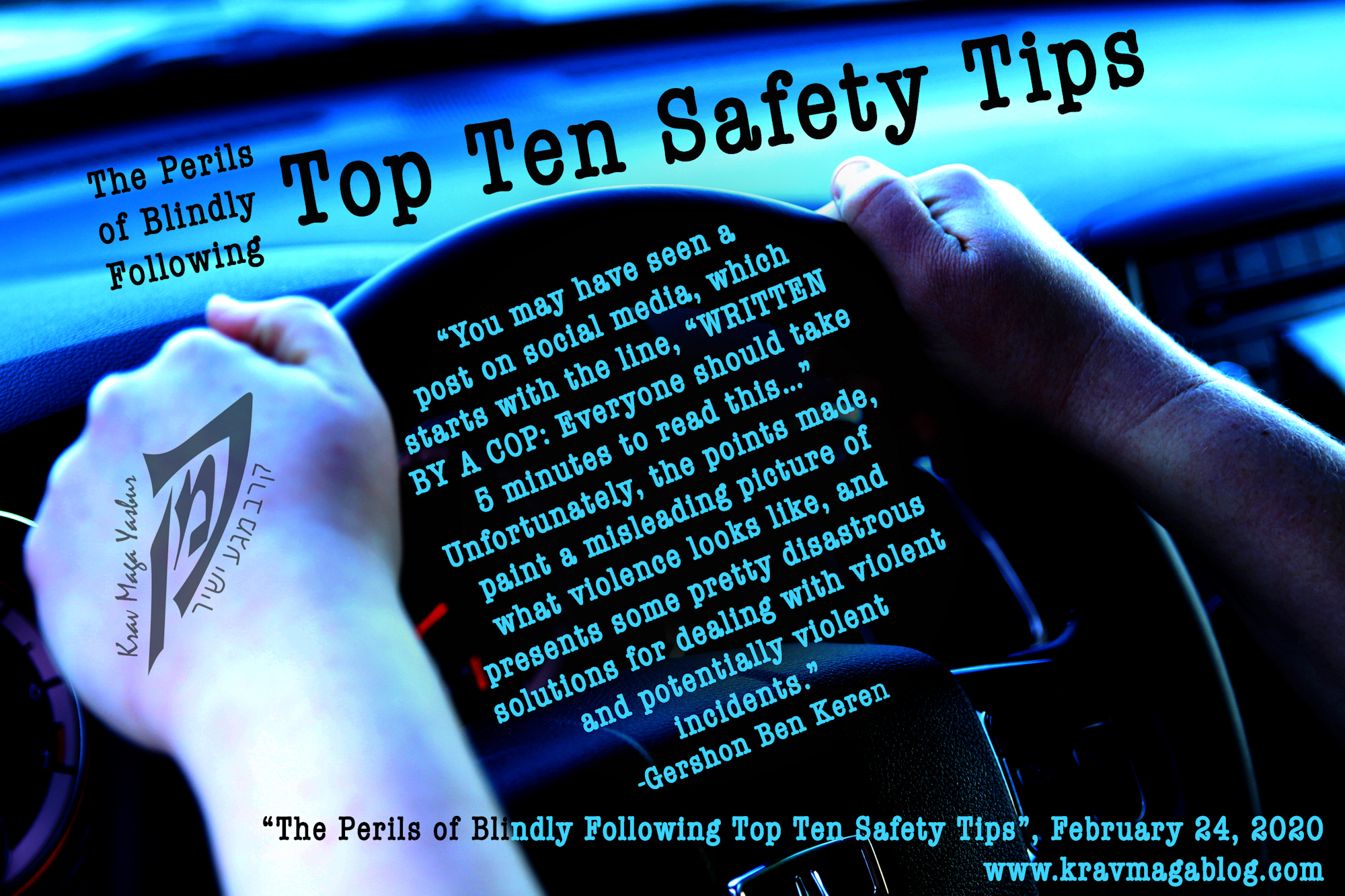The Perils Of Blindly Following Top Ten Safety Tips, is an article written by Gershon Ben Keren, a 5th Degree Black Belt in Krav Maga, who teaches Krav Maga in Boston, MA. He has also authored three Amazon best-Selling Books on Krav Maga.
You may have seen a post on social media, which starts with the line, “WRITTEN BY A COP: Everyone should take 5 minutes to read this…”, that contains a list of some ten safety tips/pieces of advice, which apparently have the potential to, “save your life”. This list (and others like it) have been doing the rounds for several years, and every now and again will appear in my news feed, often with comments thanking whoever shared it for doing so. Unfortunately, the points made, paint a misleading picture of what violence looks like, and presents some pretty disastrous solutions for dealing with violent and potentially violent incidents. In this article I want to go through some of the “tips” and evaluate the usefulness of what is being stated. I also want to discuss the general tone of the post, and the way the information is presented, as this can help us identify whether information is coming from a trusted source or not.
The first warning sign is that no author or sources are cited i.e. there is no one to question about the validity of the claims made. The information is quoted as, “WRITTEN BY A COP” as if this is proof that we should listen and take note of what is being said – this is written in capitals as if to emphasize the validity of being said – however there is no name given to the officer who purportedly wrote the list of tips – no actual source cited. The author also states that some of the advice given, came from sources like a “tourist guide”, or a “friend” etc., so although we’re supposed to believe the advice because it comes from a law enforcement officer, some of it is acknowledged as hearsay and gossip. If there is no way to validate what is being said either by being able to question and ask the person giving the advice, or by checking the source of it – for example, did it come from published research – we should be skeptical as to its legitimacy and accuracy. We live in a “gig economy”, where websites will pay freelancers a small fee to create content for them. They don’t search for experts; they will simply offer the task for somebody to collate a list of self-defense tips, and once done task them with finding the 10 best lasagna recipes, etc. The consequences of following a bad lasagna recipe cannot be compared to the consequences of following bad/dangerous personal safety advice. If somebody is prepared to give advice, they should be prepared to put their name to it, so their credentials can be evaluated.
The second, and perhaps most major warning sign, is the use of absolute statements (again written in capitals as if these statements are unquestionable), such as “ALWAYS” and “NEVER”. Solutions to violence are situational, and one solution in one incident, may not work in another seemingly similar one; the situation determines the solution, not the other way around. One piece of advice that is given is, “6. ALWAYS take the elevator instead of the stairs.” Always? I wrote about this in October of 2019, and there are many considerations, that should influence your choice of which to use e.g. the elevator at the Four Seasons in Manhattan, is very different to one that is constantly carrying gang members in a parking lot on the South Side of Chicago. The threats are also different: you may not be mugged in the elevator at the Four Seasons, but if you’re a woman, you may have to fight off the sexual advances of a drunk business man going back to is room after a “working lunch” etc. Violence is contextual, which is why there aren’t “ALWAYS” and “NEVERS”, there’s just “IT DEPENDS”. Be extremely skeptical of anyone or any advice that doesn’t acknowledge the contextual nature of violent situations and prescribes rigid and inflexible strategies that you should “ALWAYS” follow.
Number two on the list is the oft-repeated piece of advice that when dealing with a mugger/street robber, you shouldn’t hand your wallet over to them – per their demand – but to throw it away from you. The idea being that they will leave you and go to pick the wallet up, creating an opportunity for you to run. It’s a nice idea, but really that’s all it is. Firstly, it presupposes that you have the room and space to throw it on the floor, and an easy disengagement opportunity; if you’re mugged whilst at the ATM in a small to medium-sized bank lobby, this won’t be the case. It also doesn’t consider all the motives behind muggings. Whilst acquiring your resources might be the primary motive, there are reasons why certain offenders choose to commit street robberies over other property crimes, such as thefts and burglaries, etc. Muggers, are looking to interact with those they target, to enjoy a degree of power and control over them and to dispense some of their anger. These are individuals who feel entitled to take another person’s possessions, and have no/little remorse as to how their actions effect others. Once you’ve thrown the wallet, the mugger no longer needs you – you’ve given them access to it – and you’ve also taken away their sense of power and control, by not following their demand to hand it over. In an already volatile incident, you’ve just upped the ante by refusing to follow their orders; this is the time when you are most likely to be punched, stabbed, or shot, etc. Better to just hand it over and let them leave, which is the script that most muggers follow.
Some of the advice is simply outdated e.g. “If you are ever thrown into the trunk of a car, kick out the back taillights and stick your arm out the hole and start waving like crazy…The driver won't see you, but everybody else will.” Since 2002, all cars in the U.S. have been required to be fitted with an emergency truck release. This is a luminous handle, which will allow you to open the trunk – if you’re concerned about your abductor seeing this, you can do it partially – and signal to other drivers that you need help. One of my big questions concerning this list is why this is included in a top 10 safety list of do’s and don’ts i.e. being abducted and thrown into the trunk of a car may be a common movie scenario, but in reality it’s a rare and uncommon type of event – there would be much better and more appropriate advice to give if the author’s goal was actually to help people protect themselves from the types of assault they are most likely to face – before dealing with a situation from within a trunk of a car, it would be appropriate to offer ways of avoiding ending up there – beginning with understanding how to predict/identify someone’s intent, and if that fails, how to position yourself and when to fight, etc.
The advice that is given if you are in a car, and somebody has a gun to your head, is to ram your car into a wall, so the airbag goes off, saving you (giving you the opportunity to get out and run), whilst the crash renders your abductor unconscious. I feel this scenario has been pulled from a dozen movie scripts. If you crash your car at the necessary speed to both trigger the airbag, and render your abductor unconscious, you are probably not getting out of the vehicle in the same mental and physical state as you got in, if you can get out at all, i.e. you’ve been in a car crash. Also, if your abductor has his finger on the trigger, when you accelerate/crash, it’s very likely that the weapon will go off. Nice solution for the movies, where a script is being followed, but not so good for real life.
Apparently, according to the author of this list, serial killers use tape recordings (who remembers what a tape recorder is, and who still has one?) of babies crying, that they play on people’s porches to get them to open the door, and offenders will run your outside taps, at night, to get you to come outside, so that they can then attack you – what their purpose/motive is for getting you outside is never mentioned. The author’s obsession with serial killers dominates the list, however serial killers are extremely rare, and their modus operandi, differs significantly between them, which is why it is better to follow general safety precautions, rather than focus on specific signatures, that may have been used in the past. When we take into account that predatory individuals tend to be skilled social players, elaborate setups just aren’t necessary to gain access to us. What is lacking in this list, are any actionable points that can be used on a day-to-day basis, such as teaching individuals how to recognize when somebody has identified them as a target, or informing them of the types of locations that different types of criminals operate in, etc. The advice given – even when correct – is too specific to be useful, and that makes its authenticity questionable, despite the claim of “WRITTEN BY A COP”. There are a lot of articles out there giving good advice, with authors being available to justify what they say. That isn’t the case here, and so alarm bells should start ringing.
0 COMMENTS















